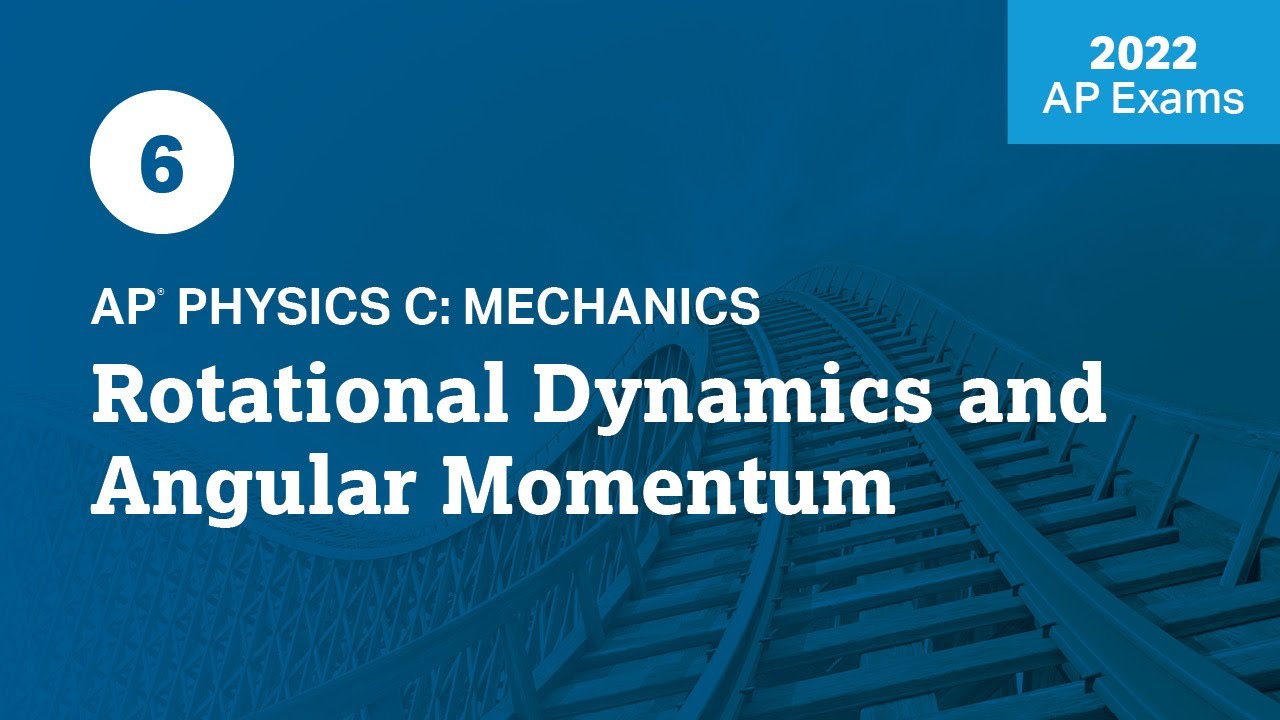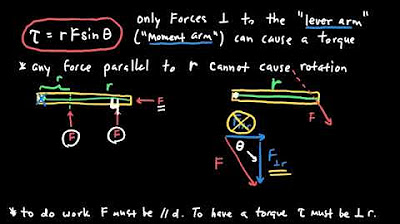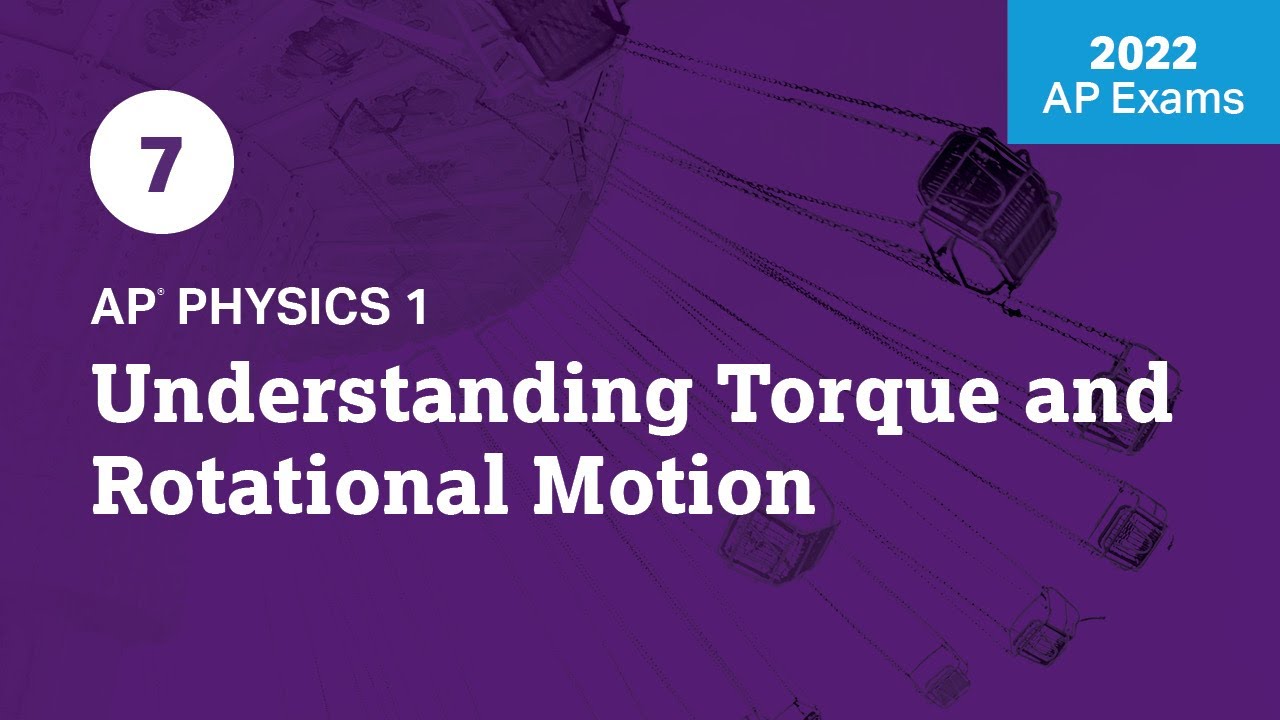2021 Live Review 8 | AP Physics 1 | Understanding Rotational Energy and Momentum
TLDRThis video script focuses on preparing students for their AP Physics 1 exam, emphasizing angular momentum and rotational kinetic energy concepts. The instructor clarifies differences between the paper and digital exam formats, provides last-minute tips, and explains key terms such as 'calculate' and 'derive'. The session also includes a discussion on rotational inertia, the conservation of angular momentum, and the relationship between linear and rotational motion. The instructor uses examples and problems to illustrate these concepts, highlighting the importance of showing work and understanding the underlying physics principles. Additionally, the video addresses the use of equipment like photogates and motion detectors in experiments and encourages students to practice problem-solving and data analysis skills.
Takeaways
- 📚 The difference between the paper and digital versions of the AP Physics 1 exam was clarified, highlighting the structure and components of each.
- ✍️ Importance of understanding the specific verbiage used in the AP exam, such as 'calculate', 'derive', 'determine', 'explain', 'plot', and 'sketch', was emphasized for accurate response formulation.
- 🔄 Angular momentum is a significant concept in rotational motion, depending on the rotational inertia and angular velocity of an object.
- 💡 Conservation of angular momentum can be applied in scenarios involving collisions in rotation or changes in rotational speed, similar to how net torque affects angular momentum.
- 📈 The relationship between linear momentum, angular momentum, and their respective kinetic energies was discussed, with formulas and principles applicable to both linear and rotational contexts.
- 📊 Graphs, such as torque vs. time and angular momentum vs. time, were explained, showing how areas under the curve represent angular impulse and net torque respectively.
- 🔧 The concept of rotational inertia was explored, with its dependence on the mass distribution of an object and how it affects the difficulty of achieving angular acceleration.
- 🎯 Examples were provided to illustrate the application of angular momentum and energy principles, including the behavior of rotating and translating objects.
- 🤸♀️ A practical example of an ice skater or gymnast was used to demonstrate the principle of conservation of angular momentum and its relation to rotational inertia and velocity.
- 🏎️ A hypothetical scenario involving a ball being pulled down by a string was used to discuss changes in kinetic energy and angular momentum.
- 🧪 The video concluded with an experiment design for determining the rotational inertia of a wheel using angular momentum concepts, emphasizing the importance of measuring relevant quantities and applying conservation laws.
Q & A
What is the difference between the paper-pencil version and the digital version of the AP Physics 1 exam?
-Both versions of the AP Physics 1 exam consist of 50 multiple-choice questions, with the last five being multiple correct answers. The difference lies in the free response and extra multiple-choice section. The digital exam includes an extra multiple-choice question and two free response questions, instead of five free response questions like in the paper-pencil version.
What should one do to prepare for the digital version of the AP Physics 1 exam?
-For the digital exam, students should ensure they have the necessary software downloaded and practice using it. They should also prepare a calculator and sharpened pencils, and bring a ruler as it is allowed on the exam.
What is the significance of the term 'verbiage' in the context of the AP Physics 1 exam?
-Verbiage refers to the specific words and phrases used in exam questions, which are structured to test particular knowledge and skills. Understanding the meaning of key verbs like 'calculate', 'derive', 'determine', 'explain', 'plot', and 'sketch' is crucial for answering questions correctly.
How does the concept of angular momentum differ from linear momentum?
-Linear momentum pertains to mass in motion in a straight line, calculated as mass times velocity. Angular momentum, on the other hand, relates to rotational motion and depends on the rotational inertia of an object and its angular velocity.
What is the relationship between torque and angular momentum?
-A net torque on an object or system will change its angular momentum, similar to how a net force changes linear momentum. The change in angular momentum is equal to the torque applied over a time period.
How can rotational inertia be determined for different objects?
-Rotational inertia is determined by the mass distribution of an object. For example, a solid sphere has less rotational inertia than a disc or a ring with the same mass because its mass is more centrally concentrated.
What is the significance of the formula L = I * ω for angular momentum?
-The formula L = I * ω represents the relationship between angular momentum (L), rotational inertia (I), and angular velocity (ω). It is used to calculate the angular momentum of an object in rotational motion.
How does the principle of conservation of angular momentum apply in a collision scenario?
-In a collision, if there is no external torque, the total angular momentum of the system is conserved. This means the initial angular momentum equals the final angular momentum, which can be used to solve for unknown quantities in collision problems.
What is the role of work in changing the energy of a system?
-Work done on a system changes its energy. Positive work increases the energy, as when a force is applied in the direction of displacement. This principle is applied when calculating changes in mechanical energy, such as when an object's potential energy is converted to kinetic energy.
How does rotational kinetic energy differ from translational kinetic energy?
-Rotational kinetic energy is associated with an object's rotation and is given by the formula (1/2) * I * ω^2, where I is the rotational inertia and ω is the angular velocity. Translational kinetic energy, on the other hand, is associated with linear motion and is calculated as (1/2) * m * v^2, where m is the mass and v is the linear velocity of the object.
What is the significance of the graph of torque versus time?
-The area under the graph of torque versus time represents the angular impulse, which is the change in angular momentum. This is analogous to the impulse (change in linear momentum) in a force versus time graph.
Outlines
📝 Exam Preparation and AP Physics 1 Review
The paragraph discusses the upcoming AP Physics 1 exam preparation, highlighting the differences between the paper-pencil and digital exam formats. It emphasizes the importance of understanding the exam structure, including the multiple-choice and free-response sections. The speaker also provides last-minute tips and tricks for tackling the exam, such as the need for a calculator, sharpened pencils, and a ruler. Additionally, the paragraph delves into the nuances of verbiage used in the exam, explaining the implications of terms like 'calculate', 'derive', and 'determine', and their impact on how students should approach problem-solving. The speaker also touches on the significance of showing work and the general rule of rounding to significant figures.
🌀 Angular Momentum and Rotational Energy
This paragraph focuses on the concepts of angular momentum and energy in rotation. It begins by drawing parallels with linear momentum, explaining that angular momentum is related to an object's rotational inertia and angular velocity. The speaker then discusses the applicability of these concepts, particularly in scenarios involving collisions or changes in angular momentum. Key equations such as L=Iω (angular momentum) and the rotational kinetic energy formula are introduced. The paragraph further explores the implications of torque and time graphs, rotational inertia, and provides insights into how the distribution of mass affects an object's rotational inertia. Examples and graphs are used to illustrate these concepts, emphasizing the importance of understanding these principles for the exam.
🚀 Translational and Angular Momentum in Motion
The paragraph delves into the relationship between translational motion and angular momentum, using the example of a plane flying by a window and the observer's head rotation. It explains how even non-rotating objects can have angular momentum about a point. The speaker clarifies the calculation of angular momentum for a point mass and emphasizes the importance of the perpendicular distance to the velocity in these calculations. The paragraph also discusses the conservation of angular momentum and its relationship with torque and impulse, providing examples of real-life scenarios such as an ice skater and a gymnast to illustrate the concepts. The energy conservation principle is applied to these examples, highlighting the transformation of different forms of energy.
🏎️ Energy Conservation in Rotational Motion
This paragraph examines the conservation of energy in rotational motion, using the example of a hoop and a disk rolling up a ramp. It compares their rotational and translational kinetic energies and discusses how the conservation of energy principle can be applied to predict which object will reach a higher point on the ramp. The speaker introduces the concept of rotational kinetic energy and explains how it depends on rotational inertia and angular velocity. The paragraph also includes a detailed analysis of the forces and energy transformations involved, emphasizing the importance of understanding these principles for solving problems related to rotational motion.
🤔 Problem Solving with Angular Momentum
The paragraph presents a problem-solving scenario involving a ball swung in a circle and its angular momentum and kinetic energy changes when the radius of its path is altered. The speaker guides the audience through a step-by-step analysis, considering work done, torque, and energy transformations. The problem is approached from both a graphical perspective, using diagrams, and an analytical perspective, using equations. The speaker emphasizes the importance of understanding the relationships between physical quantities and the conditions for conservation of angular momentum. The paragraph concludes with a discussion of rotational inertia and its impact on the outcome of the problem.
🧠 Free Response and Experimental Design
This paragraph introduces a free-response question and an experimental design task, both of which are part of the exam. The free-response question involves a scenario where a disk collides with a rod, and students are asked to determine the optimal point of collision for maximum angular speed. The speaker provides guidance on approaching the problem qualitatively and quantitatively. The experimental design task involves determining the rotational inertia of a wheel using angular momentum concepts. The speaker outlines the procedure, including the data to be collected, the equipment to be used, and the steps to be followed. The paragraph emphasizes the importance of clear and accurate experimental procedures and data analysis in determining physical quantities such as rotational inertia.
🎯 Conclusion and Final Remarks
In the concluding paragraph, the speaker wraps up the session by reiterating key takeaways about linear and angular momentum, and their conservation under certain conditions. The speaker also provides encouragement and advice for the upcoming exam, urging students to fill in all sections and use their knowledge to make educated guesses where necessary. The paragraph ends with a message of support and well-wishes for the students' success in their exams.
Mindmap
Keywords
💡Angular Momentum
💡Rotational Kinetic Energy
💡Conservation of Angular Momentum
💡Torque
💡Rotational Inertia
💡Free Response Questions
💡Digital Exam
💡Verbiage
💡Impulse
💡Graphs
Highlights
Discussion of the differences between the paper and digital versions of the AP Physics 1 exam, including the number of multiple-choice questions and the format of the free response section.
Emphasis on the importance of being prepared for the exam, including having the necessary tools such as a calculator, sharpened pencils, and a ruler.
Explanation of the verbiage used in the AP exam, particularly the difference between 'calculate' and 'derive', and the expectation to show all work for these types of questions.
Clarification of the terms 'determine', 'explain', 'plot', and 'sketch' as used in the context of the AP Physics 1 exam.
Introduction to the concept of angular momentum, its definition, and how it differs from linear momentum.
Discussion of the formula for angular momentum (L = I * ω) and how it relates to rotational inertia and angular velocity.
Explanation of how to use graphs, such as torque vs. time and angular momentum vs. time, to understand and solve problems in physics.
Introduction to rotational kinetic energy and its relation to rotational inertia and angular velocity, with the formula (KE = 0.5 * I * ω^2).
Illustration of how rotational inertia can be affected by the distribution of mass in an object, using examples of a solid sphere, a disc, and a hollow hoop.
Demonstration of how an object in translation can have angular momentum about a point, using the example of an airplane flying past a person who turns their head to watch it.
Explanation of how to calculate the angular momentum of a translating object using the formula (L = m * v * r), where r is the perpendicular distance from the pivot point.
Discussion of how the application of torque can change the angular momentum of an object, and how this relates to the concept of impulse.
Introduction to the conservation of angular momentum, and how it can be used to analyze scenarios such as a spinning ice skater pulling in their arms.
Explanation of how changes in rotational inertia can affect the angular velocity of an object, using the example of an ice skater and a gymnast.
Discussion of the relationship between work, force, and displacement, and how it relates to the conservation of energy in a system.
Illustration of the conservation of energy principle using the example of a hoop and a disc rolling up a ramp, and how their rotational kinetic energy affects their final height.
Introduction to the concept of angular impulse, and how it can be determined from a torque vs. time graph.
Explanation of how to calculate the net torque on an object or system using the slope of an angular momentum vs. time graph.
Transcripts
Browse More Related Video

2022 Live Review 6 | AP Physics C: Mechanics | Rotational Dynamics and Angular Momentum

AP Physics 1 Torque and Rotational Motion Review

AP Physics 1 review of Torque and Angular momentum | Physics | Khan Academy

AP Physics 1 - 10 Minute Recap

Rotation Free Response Paragraph Questions (AP Physics 1)

2022 Live Review 7 | AP Physics 1 | Understanding Torque and Rotational Motion
5.0 / 5 (0 votes)
Thanks for rating: